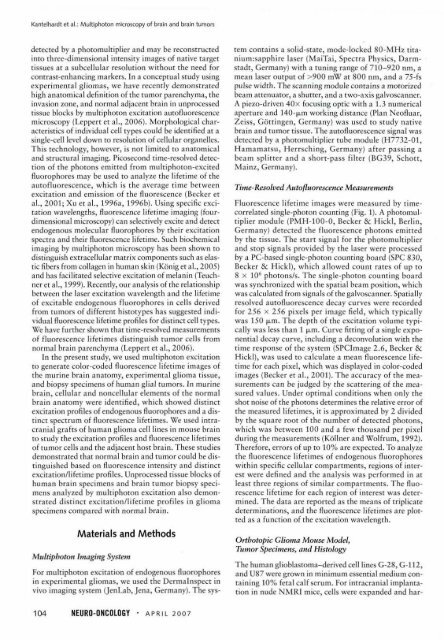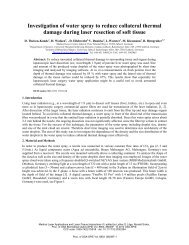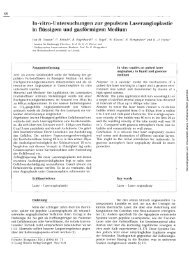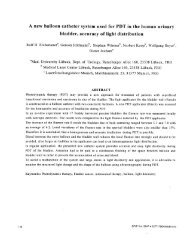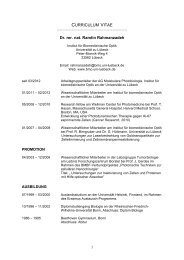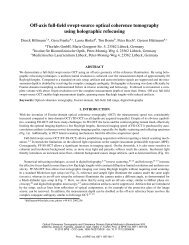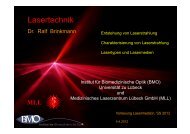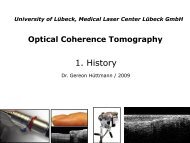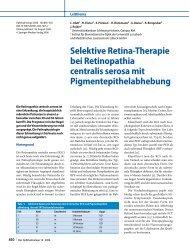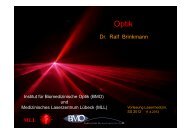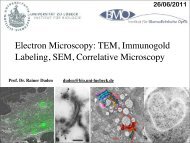neuro-oncology
neuro-oncology
neuro-oncology
Create successful ePaper yourself
Turn your PDF publications into a flip-book with our unique Google optimized e-Paper software.
Kantelhardt et al.: Muläphoton mlcrnscopy of brain and brain tumo~<br />
detected by a photomultiplier and may be reconstructed<br />
into three-dimensional intensity images of native target<br />
tissues at a subcellular resolution without the need for<br />
conmst-enhancing markers. In a conceptual study using<br />
experimental gliomas, we have recently demonstrated<br />
high anatomicai definirion of the tumor parenchyma, the<br />
invasion zone, and normal adjacent brain in unprocessed<br />
tissue blocks by multiphoton excitation autofluorescence<br />
microscopy (Leppert et aL, 2006). Morphologicai daracteristics<br />
of individuaI cell rypes could be identi6ed ar a<br />
singie-cell lwel down to resolution of ceIluiar organeiies.<br />
This technology, however, is not limited to anatomical<br />
and structural imaging. Picosecond time-resolvd detection<br />
of the photons trnitted from multiphotoa-excited<br />
fluorophores may be used to analyze the Iifetime of the<br />
autofluorescence, which is the average time between<br />
excitation and ernission of the fluorescence (Becker et<br />
al., 2001; Xu et al., 1996a, 1996b). Using specific excitation<br />
wavelengths, fluorescence lifetime imaging (fourdimensional<br />
rnicrosmpy) can selehvely excite and derect<br />
endogen~us molecular fluorophores by their excitation<br />
spectra and tbeir fluorescence lifetime. Such biochemical<br />
imaging by multiphoton microscopy has been shown to<br />
discinguish extracellular matrix componentc such as dastic<br />
fibers from collagen in human skm (König et al., 2005)<br />
and has faciiitated selective excitation of rnelanin (Teuchner<br />
et at., 1999). Recently, our analysis of the rdationship<br />
between the laser excitation wavelength and the lifetime<br />
of excitable endogenous fluorophores in cells derived<br />
from tumors of different histotypes has suggested individual<br />
fluorescence lifetime profiles for distinct cell types.<br />
We have further shown that time-resoived measurements<br />
of fluorescence lifetimes distinguish turnor cdls from<br />
normal brain parenchyma (Leppert et al., 2006).<br />
In Lhe present study, we used multiphoton excitation<br />
to generate color-coded ff uorescence Iifetime images of<br />
the murine brain anatomy, experimental gliorna tissue,<br />
and biopsy specimens of human glial tumors. In murine<br />
brain, cellular and noncelluIar elements of the normal<br />
brain anatomy were identifred, which showed distinct<br />
excitation profiles of endogenous fluorophores and a disthct<br />
spectrum of fluorescence lifetimes. We used intracranial<br />
grafts of human glioma ceIl lines in rnouse brain<br />
to smdy the excitation profiles and fluorescence lifetimes<br />
of tumor cells and the adjacent host brain. These studies<br />
demonstrated that normal brain and turnor could be distinguished<br />
based on fluorescence incensity and distinct<br />
excitationllifetime profiles. Unprocessed tissue b lds of<br />
human brain specimens and brain tumor biopsy specimens<br />
analyzed by multiphoron excitation also dernonstrated<br />
distinct excitationllifetime profiles in glioma<br />
spccimens compared with normal brain.<br />
Materials and Methods<br />
For multiphoton excitation of endogenous fluorophores<br />
in experimental gliarnas, we ucd the DermaInspect in<br />
viv0 imging system (JenLab, Jena, Germany). The sys-<br />
tem contains a solid-state, mode-locked 80-MHz tiraniumsapphire<br />
laser (MaiTai, Spectra Physics, Darmstadt,<br />
Germany) with a tuning raage of 710-920 nm, a<br />
mean laser output of >900 rnW at 800 nm, and a 75-fs<br />
pulse width. The scanning module conrains a motorized<br />
beam attenuator, a shutter, and a two-axis galvoscanner.<br />
A piezo-driven 40x focusing optic with a 1.3 numerical<br />
aperture and 140- km working distance (Plan Meofluar,<br />
Zeiss, Göttingen, Germany) was used to study native<br />
brain and tumor tissue. The autofluorescence signai was<br />
detected by a photomultiplier tube module (H7732-01,<br />
Hamamatsu, Herrsching, Gerrnany) after passing a<br />
beam splitter and a short-pass filter (BG39, Schott,<br />
Mainz, Germany).<br />
Fluorescence lifetime images were measured by timecorreiared<br />
single-photon counting (Fig. 11, A photomuIriplier<br />
modute (PMH-100-0, Becker & Hickl, Berlin,<br />
Germany) detected the fluorescence photons ernitted<br />
by rhe tissue. The start signal for the phatomultipIier<br />
and stop signaIs provided by the laser were processed<br />
by a PC-based single-photon counting board (SPC 830,<br />
Becker & Hickl), which allowed Count rates of up to<br />
8 X 106 photonsls. The single-photon counting board<br />
was synchronized with the spatial beam position, which<br />
was calculated from signals of the galvoscanner. Spatially<br />
resolved autofluorescence decay curves were recorded<br />
for 256 X 256 pixels per image field, which typically<br />
was 150 Pm. The depth of the excitation volume typically<br />
was less than 1 Pm. Curve fitting of a single exponential<br />
decay curve, including a deconvolution with the<br />
time response of the system (SPCImage 26, Becker &<br />
Hickl), was used to calculate a mean fluorescence iifetime<br />
for each pixel, which was displayed in color-coded<br />
images (Becker et al., 2001). The accuracy of the measurements<br />
can be judged by the scattering of the measured<br />
values. Under optimal conditions when only the<br />
shot noise of the photons determines rhe relative mor of<br />
the measured lifetimes, it is approximated by 2 divided<br />
by the square root of thc numbex of detected photons,<br />
which was between 100 and a few rhousand per pixei<br />
during the measurements (Köllner and Wolfrum, 1992).<br />
Therefom, errors of up ta 10% are expeaed. To analyze<br />
the fluorescence Iifetimes of endogenous fluorophores<br />
within specific ceIIular compartments, regions of interest<br />
were defined and the analysis was performed in at.<br />
least three regions of similar cornpartments. The fluorescence<br />
lifetime for each region of interest was determined.<br />
The data are reported as the means of triplicate<br />
determinations, and the fluorescence lüetimes are plotted<br />
as a function of the excitation wavekngrh.<br />
Wot& Gliw Mouse Mo&&<br />
Tmr Spedmau, arid Hcstology<br />
The human glioblastoma-derived cdl lines G-28, G-112,<br />
and U87 were- grown in minimum essential medium containing<br />
10% fetal calf serum. For intracranial implantation<br />
in nude NMRI mice, cells were expanded and bar-<br />
NEURO-OHCOLOGY A P R I L 2 007


